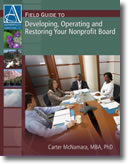How to Evaluate a Board of Directors and Each Board Member (For-Profit or Nonprofit)
© Copyright Carter McNamara, MBA, PhD, Authenticity Consulting, LLC.
Sections of This Topic Include
- General Guidelines for Evaluating Board of Directors (For-Profit and Nonprofit)
- Guidelines for Selecting Tools to Evaluate Your Board
- Sample Procedures to Evaluate Entire Board
- Sample Procedures for Board Members to Self-Evaluate
Also consider
Related Library Topics
Also consider
Evaluating the Chief Executive Officer (CEO)
General Guidelines for Evaluating Boards of Directors (For-Profit and Nonprofit)
Board Members Legally Responsible for Effective Boards
Board members are accountable to their constituents to ensure that their organization (for example, for-profit or nonprofit corporation) is indeed effectively working toward its legally specified purpose, as specified in its charter document. It is not unusual for members of a Board to fall into the same old way of doing things, an approach that becomes quite stale and even ineffective. One of the ways to quickly identify this problem is for the Board to conduct a self-evaluation.
Strong Reasons and Benefits for Regular Board Evaluations
Many times, Board members do not know what they do not know about their own Board. For example, they might be terribly ineffective because they all have fallen into a rut in their operations — and they have not even realized it. Or, they might have gotten side-tracked into attending to certain urgent matters (for example, the latest crisis reported by the Chief Executive Officer), and are ignoring very important matters (for example, strategic planning that would have avoided those crises altogether).
Board members who claim that they do not need evaluation and Board training are like obese people who claim that they do not need advice about eating because, after all, they are already experts at eating. Experienced and highly effective Board members have learned that it’s critical to regularly conduct short, practical evaluations of the quality of their Board operations and then to attend to the results of those evaluations during the year. Evaluations need not take a long time — many times, even 15 minutes a year from each Board member to complete a short questionnaire, followed by half an hour to discuss results, can be transformational for a Board.
Timing to Do a Board Evaluation
A Board should evaluate its operations at least once a year. Don’t wait until new members have learned more about the Board — that’s like waiting until you feel fine before seeing the doctor.
A very useful time for evaluation is early in the strategic planning process. Results of the evaluation can be included as strategic goals in the organization’s strategic plan
Wide Variety of Board Evaluation Tools
Below, is a list of a variety of free Board self-evaluation tools. Aim to select a tool that asks at least as much about the actual occurrence of activities on your Board as about how members feel about the Board. It’s good practice to have a small team of Board members, for example, a Board Governance Committee, review and select the best tool.
How to Use Board Evaluation Tools
It’s often best if each Board member completes a tool on his/her own, rather than together in a group. Otherwise, any problems they have in their Board meetings are carried into how they do the Board evaluations, as well.
It’s also best if each member can provide anonymous input to the evaluation questionnaire. Boards can often get much more honest feedback that way.
Results of the evaluation should be included in a Board Development Plan. The status of the implementation of that Plan should be a topic on the agenda of each Board meeting.
Guidelines for Selecting Tools to Evaluate Your Board
There are a wide variety of available tools for evaluating a Board of Directors. However, it’s very important that the tool, for example, the questionnaire, you select matches the culture of the people who will respond to the questions, as well as the purpose of your Board evaluation.
For example, some cultures consider questions that start with “why” to be disrespectful, while others consider questions about feelings to be disrespectful. Thus, you should always acculturate the questions in your tool. Here are guidelines to do that.
How to Acculturate Tools for Evaluations
If you plan to select from among an already available set of tools, then here are some overall guidelines for doing that. They are excerpted from the book that is listed at the top of the document.
How to Select from Among Public Data Collection Tools
If you decide to design your own evaluation tool, then these guidelines might be useful.
How to Design Successful Evaluation and Assessment Plans
Sample Procedures to Evaluate Entire Board
For-Profit (Corporate) Boards
Recommended
- Corporate (For-Profit) Board Evaluation Form (includes scoring)
- Evaluation of For-Profit (Corporate) Board of Directors
Also consider
- Board Performance Evaluations that Add Value
- What is a Board Evaluation Report?
- Global Board Evaluation Practices and Trends
- Qualifications and Evaluations of Directors and Boards (European study of Board composition and qualifications of directors; applies to USA; for-profits)
- Relative Performance Evaluation and Related Peer Groups (studies use of peer-based evaluations; for-profits)
- Board Structure and Monitoring (shows mixed results of including independent directors; for-profits)
- Improving board effectiveness: Five principles for getting the most out of a board assessment
(guidelines for evaluating Board; for-profits) - Elevating Board Performance (argues that lack of attention to monitoring hampers performance;
for-profits) - Guilty As Charged: Prove Your Board Supports Your Organization (considerations whether Board really supports organization; nonprofits)
- Evaluating The Board Of Directors (checklist for investors to evaluate boards; for-profits)
- For-Profit Organizational Assessment Questionnaire
Nonprofit Boards
Recommended
Nonprofit Board Evaluation Form (includes scoring)
Also consider
- Board of Directors Evaluation (form to evaluate Board; nonprofits)
- Checklist to Evaluate a Nonprofit Board of Directors (checklist for evaluating: nonprofits)
- Jean Freeman: Board Self-Assessment (general guidelines for doing Board evaluations; nonprofits)
- Board Self-Evaluation (assessment form; nonprofits)
- Checklist to Evaluate Health of Board (evaluation form; nonprofits)
- Self Assessment for the Board (evaluation questionnaire; nonprofits)
- Center for Nonprofit Resources (nonprofit best practice checklist; nonprofits))
- Governance Health Check (code of good governance questionnaire; nonprofits)
- Nonprofit Organizational Assessment Questionnaire
Sample Procedures for Board Members to Self-Evaluate
These forms are used by each Board member to evaluate the quality of their own personal participation in the Board, rather than evaluating the Board as a whole.
- Individual Board Member Self-Evaluation (nonprofit)
- Board of Directors Self-Evaluation (nonprofit)
›Return to All About Boards of Directors
Learn More in the Library’s Blogs Related to This Topic
In addition to the articles on this current page, also see the following blogs that have posts related to this topic. Scan down the blog’s page to see various posts. Also see the section “Recent Blog Posts” in the sidebar of the blog or click on “next” near the bottom of a post in the blog. The blog also links to numerous free related resources.
For the Category of Boards of Directors:
To round out your knowledge of this Library topic, you may want to review some related topics, available from the link below. Each of the related topics includes free, online resources.
Also, scan the Recommended Books listed below. They have been selected for their relevance and highly practical nature.











